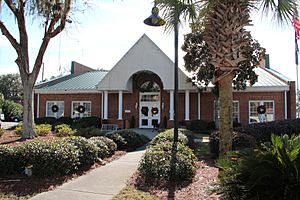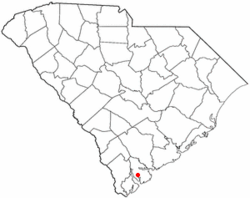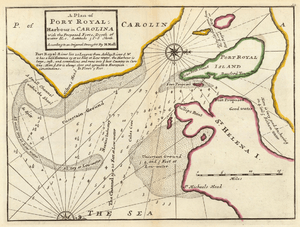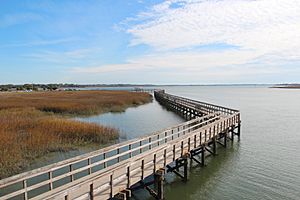Port Royal, South Carolina facts for kids
Quick facts for kids
Port Royal, South Carolina
|
||
|---|---|---|

Port Royal Municipal Offices
|
||
|
||

Location of Port Royal, South Carolina
|
||
| Country | United States | |
| State | South Carolina | |
| County | Beaufort | |
| Area | ||
| • Town | 19.55 sq mi (50.64 km2) | |
| • Land | 16.96 sq mi (43.94 km2) | |
| • Water | 2.59 sq mi (6.70 km2) | |
| Elevation | 23 ft (7 m) | |
| Population
(2020)
|
||
| • Town | 14,220 | |
| • Density | 838.20/sq mi (323.63/km2) | |
| • Urban | 52,515 (US: 487th) | |
| • Urban density | 1,200.1/sq mi (463.3/km2) | |
| Time zone | UTC-5 (Eastern (EST)) | |
| • Summer (DST) | UTC-4 (EDT) | |
| ZIP code |
29935
|
|
| Area code(s) | 843, 854 | |
| FIPS code | 45-58030 | |
| GNIS feature ID | 1250223 | |
| Website | www.portroyal.org | |
Port Royal is a town on Port Royal Island in Beaufort County, South Carolina, United States. The population was 14,220 at the 2020 census. It is part of the Hilton Head Island–Bluffton metropolitan area. Port Royal is home to Marine Corps Recruit Depot Parris Island and United States Naval Hospital Beaufort.
Contents
History
Port Royal takes its name from the adjacent Port Royal Sound, which was explored and named by Frenchman Jean Ribault in 1562. Ribault founded the short-lived settlement of Charlesfort on Parris Island. The area later became the site of a Spanish and still later Scottish colony during the 17th century.
Port Royal was the site of the Naval Battle of Port Royal during the Civil War. Later during the war, it was the one of the sites of the Port Royal Experiment, which included most of the Sea Islands in Union hands. In 1863, the Emancipation Proclamation was first read at Christmas under the Proclamation tree in Port Royal.
Due to the benefits of a large and sheltered natural harbor, Port Royal was able to develop port facilities to support the growing phosphate mining activities after the Civil War. The Port Royal Railroad was completed from Port Royal to a junction with the main Charleston and Savannah Railway in Yemassee, thus establishing a land route for trade and commerce. Port Royal was the southeastern terminus of the Charleston and Western Carolina Railway, the railroad last had passenger trains to Port Royal in the mid-1950s. Development of a community around the previously isolated port site at the end of the Beaufort River and Battery Creek led to the platting of streets and town lots by development interests. A land rush ensued, and Port Royal was officially incorporated in 1874, 300 years after initial settlement efforts.
The Sea Islands Hurricane of 1893 destroyed much of the phosphate industry and stunted development, but the port continued to operate throughout the 20th century. The opening of Parris Island as a Marine Corps recruiting station brought some vitality back to the community, though rapid residential growth did not occur until the later decades of the 20th century. The port's vitality however began to decline as the State of South Carolina began to focus on dredging Charleston's harbor and expanding port facilities further up the coast. In an effort to save costs, the State Ports Authority closed the port facility in Port Royal in 2004. Efforts to redevelop have been ongoing but been hampered by the Great Recession. Due to annexation, including Parris Island, the population of Port Royal rose from 3,950 in 2000 to 10,678 in 2010, a 170% increase.
The Camp Saxton Site, Fort Frederick Heritage Preserve, Hasell Point Site, Little Barnwell Island, F.W. Scheper Store, and Union Church of Port Royal are listed on the National Register of Historic Places.
Neighborhoods
The Old Village is the historic center of Port Royal. Streets running north–south are named after the capitals of nations whose immigrants have settled in the Port Royal area (Paris, London, Madrid, and Edinburgh). Paris Avenue is the primary commercial street in the Old Village. Immediately north of the Old Village is a low-density residential area known as Mossy Creek, which crosses over into incorporated areas of the city of Beaufort to the north. A large portion of Port Royal's population lives in the Preserve at Port Royal Apartments, in between the Old Village and Mossy Creek.
Historically, Port Royal's municipal boundaries were defined by Beaufort to the north, the Beaufort River to the east, Parris Island to the south, and Battery Creek to the west. Since the start of the 21st century however, Port Royal began to annex lands west and south of its core area. The Parris Island Marine Corps Base was annexed on October 11, 2000, effectively doubling the municipal population overnight due to on-base housing. Port Royal also annexed properties in the Shell Point and Burton areas of Beaufort County.
Challenges were filed, and the 2000 annexation of undeveloped Rose Island was to be heard by the South Carolina Supreme Court in 2005. Town representatives said the city annexed Rose Island because it was within the "line of sight" of the Doggett Tract, a group of islands off Shell Point already under the town's jurisdiction.
In 2006, Port Royal annexed two tracts of land south of the Broad River based on the so-called line-of-sight rule.
Culture
In film
The hurricane scene from the 1994 film Forrest Gump was filmed in the town's dock area.
Community events
Paris Avenue (the main street of the Old Village) periodically hosts Street Music events throughout the year. Port Royal also hosts an annual soft shell crab festival in late April and a community oyster roast in late October. Beaufort Charities hosts its annual Oyster Roast in Live Oaks Park in March.
Geography

Port Royal has expanded in recent times by annexation of parcels of land on the west side of Battery Creek.
According to the United States Census Bureau, the town has a total area of 22.0 square miles (57.0 km2), of which 19.0 square miles (49.1 km2) is land and 3.1 square miles (7.9 km2), or 13.92%, is water.
Demographics
| Historical population | |||
|---|---|---|---|
| Census | Pop. | %± | |
| 1880 | 170 | — | |
| 1890 | 524 | 208.2% | |
| 1900 | 601 | 14.7% | |
| 1910 | 363 | −39.6% | |
| 1920 | 383 | 5.5% | |
| 1930 | 353 | −7.8% | |
| 1940 | 342 | −3.1% | |
| 1950 | 793 | 131.9% | |
| 1960 | 686 | −13.5% | |
| 1970 | 2,865 | 317.6% | |
| 1980 | 2,977 | 3.9% | |
| 1990 | 2,985 | 0.3% | |
| 2000 | 3,950 | 32.3% | |
| 2010 | 10,678 | 170.3% | |
| 2020 | 14,220 | 33.2% | |
| 2022 (est.) | 15,632 | 46.4% | |
| U.S. Decennial Census[1] | |||
2020 census
| Race | Num. | Perc. |
|---|---|---|
| White (non-Hispanic) | 8,323 | 58.53% |
| Black or African American (non-Hispanic) | 2,773 | 19.5% |
| Native American | 38 | 0.27% |
| Asian | 327 | 2.3% |
| Pacific Islander | 14 | 0.1% |
| Other/Mixed | 652 | 4.59% |
| Hispanic or Latino | 2,093 | 14.72% |
As of the 2020 United States census, there were 14,220 people, 3,868 households, and 2,291 families residing in the town.
Transportation
Port Royal is served by U.S. Highway 21, and S.C. Highways 128, 170, and 281. The Marine Corps Crossing Bridge (U.S. 21) connects the Old Village with Parris Island and newly annexed areas in the Shell Point area. Port Royal was previously the terminus for the Port Royal Railroad, which is being converted to the Spanish Moss Trail, a 14.9-mile rail trail (24.0 km) connecting the town with Beaufort and other communities to the north.
Notable person
- General Randolph M. Pate (1898–1961), Commandant of the Marine Corps, 1956-1959
See also
 In Spanish: Port Royal (Carolina del Sur) para niños
In Spanish: Port Royal (Carolina del Sur) para niños



